
Rarotonga
Southern Cook Islands
August 2010
Part Four
| |
| HOME |
| About Tenaya |
| About Us |
| Latest Update |
| Logs from Current Year |
| Logs from Previous Years |
| Katie's View |
| Route Map |
| Links |
| Contact Us |
![]()
August 29, 2010
We dropped the mooring ball in front of the Bora Bora Yacht Club at 0845 the morning of August 20 and headed off to Rarotonga 550 miles to the southwest.
As we sailed through the short pass something to port caught my eye but looking closely I saw nothing unusual. Then all of a sudden something broke the surface and a small geyser-like spray shot up. A whale! No, a whale and her calf! They frolicked playfully for a couple of minutes before diving out of sight. What a great send off from such a beautiful place.
The sky a brilliant blue with winds 18-22 knots from astern, only the confused seas kept the conditions from being ideal. As we put another reef in both sails at 2100 that evening a red-footed booby hovered over the stern a moment before landing on the pushpit. There he stayed.
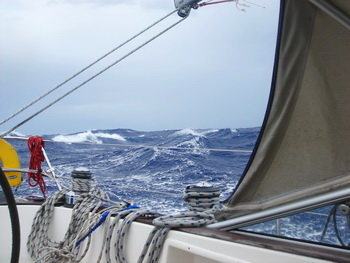
Entries in our logbook that night are as follows: 2300 - Lightening ahead, wind 22 knots. 0202 - Wind shifting, boom banging, wind 12 knots. 0320 - Lightening, heavy rain, wind 25+ knots. 0500 - Heavy rain, lightening winds 30+.
I awoke shortly after 0300 to find continuous flashes of light through the small windows of the rear cabin and could hear the rain pounding heavily on deck. Crawling out of my sea bunk to check on Jim, I was surprised to find him sitting on the floor of the main saloon with the companionway all sealed up. In answer to my puzzled expression he said, "It's raining like crazy out there, blowing over 30 knots and I couldn't see a thing so I took down the sails and we're motoring very slowly at the best angle to the waves I could find. Didn't make much sense to stay up there." So we curled up together on the floor with our pillows and waited it out.
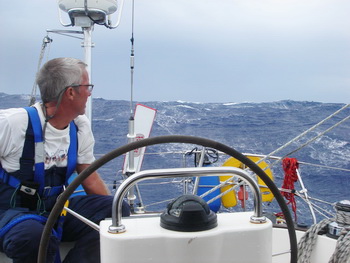
From time to time one of us popped our head out to have a look around. Each time we were greeted, face to face, with the alert booby who had moved into the cockpit and stood just on the other side of the washboards. Guess he wasn't getting any sleep either.
The logbook goes on: 0700 - Rain, waves, wind - not fun. 0820 - Waves appear large, 4 meters? 0900 Gusts in the 40s. 1000 - A little sun poking through clouds, rolly. 1230 - Sails up. 1500 a little sunshine through the clouds. 1800 - Sun is finally out! 1900 - Sails flappering in the light wind. 2000 - cottony clouds, slightly higher winds. 2100 - Bright night! Almost full moon. 0300- Perfect night! Full moon, calm seas.

The remainder of our passage was delightful. Mostly sunny skies with winds of 14-18 knots made for splendid days. Nights were positively magical in the glow of the full moon.
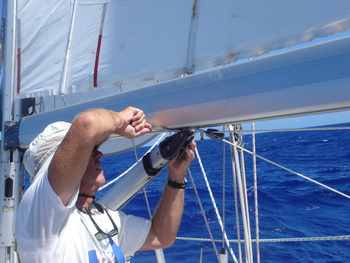
The calm weather allowed Jim to easily tighten some loose bolts on the boom vang. After the winds from the first night, this was the only problem he found when inspecting the rigging.
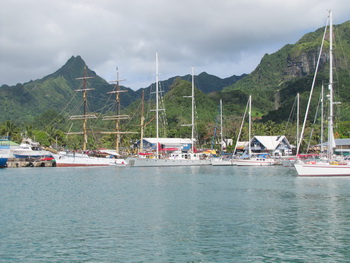
Majestic verdant mountains rise in the center of the island which is surrounded by a reef. Avatiu, the only harbor on the island where a sailing yacht may enter, is described cautiously in the guide books.
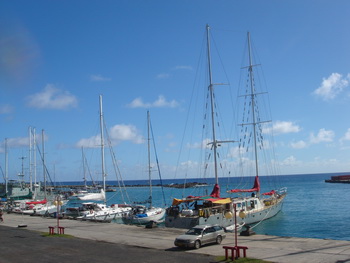
Charlie's Charts informs us: "It is extremely limited in space and access for the small, square basin is cut out of the reef ... Local trading and fishing vessels have priority in the harbor. This can be a dangerous harbor to visit since deep sea vessels maneuvering in the confined space sometimes collide with and damage yachts tied ashore. Cruising vessels must moor Med-style and be ready to move with short notice in the event of a ship arriving or strong winds from a northerly quarter which can make the harbor untenable.
The Pacific Crossing Guide notes: "...Much better to arrive in daylight because the harbour is a web of mooring lines and anchor chains that would be a menace to negotiate in the dark."
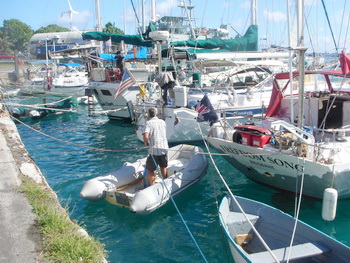
As we approached the island I called the harbormaster and was thanked for giving him advance notice of our arrival via email. He said to tie to the south wall in one of the gaps. We dropped the anchor and eased back to the wall where a helpful yachtie took our windward line and dropped the loop around a large bollard. Pulling the line tight and cleating it off, I threw him the leeward line and repeated the drill. Easy as pie! Once the dinghy was down we tied additional lines adding our own web to the quay.
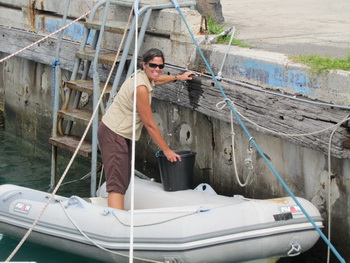
The concrete quay is too high and far from where a skipper wants his stern for a passerelle so the practice here is to ferry back and forth in the dinghy. A water spout is next to the stairs makes an easy spot to fill the bucket for laundry.

The harbor is close to the pleasant main town of Avarua. Lined with restaurants, galleries and pearl shops, it obviously caters to tourists but is not the least bit tacky. Many folks from New Zealand and Australia visit but we only heard American accents twice though perhaps they were Canadian.
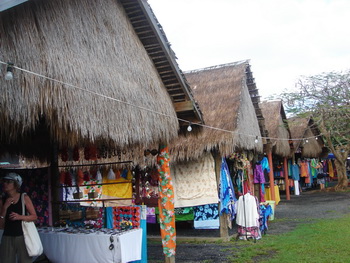
Nearby is the Punanga Nui Market where gleaming fresh fruit, veggies and fish can be found each morning. The market explodes in brilliant colors and a myriad of stalls on Saturday mornings where many women wear wreaths of fresh flowers in their hair. It is the place to be for locals and visitors alike.
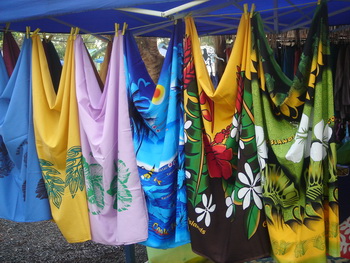
Vibrant pareus and brightly colored apparel wave in the breeze while black pearls from the Northern Cook Islands and jewelry made from shells and carved wood are displayed creatively. Wooden carvings of Tangaroa, the well endowed god of fertility are mixed in with carved bowls and wall hangings. Wooden masks hang above stacks of geometrically shaped drums and ukuleles. Necklaces and crowns of fresh flowers decorate other stands.
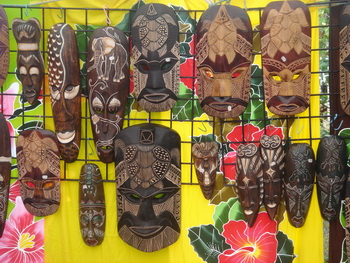
Scrumptious scents lead to tables of freshly baked bread, grills loaded with searing meat and stands heaped with fresh fruit selling smoothies.
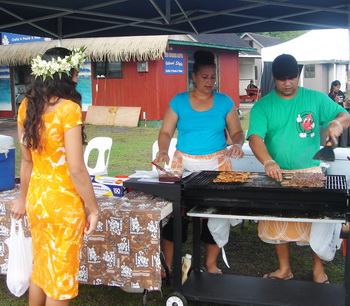
The island is flat all the way around the 32 km long coastal road. Buses run clockwise and counter clockwise each half hour. We hopped on one to have a tour of the island and got off at several top snorkeling spots to scout for another day.
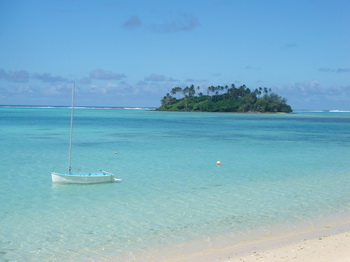
Muri Beach, Tikioki Beach, Titikaveka and Aro'a Beach are all along the shimmering turquoise lagoon. A gentle breeze blew as we wandered along the fine sand under the dazzling blue sky ogling at the romantic bungalows nestled in the palms and hibiscus steps from the inviting water.
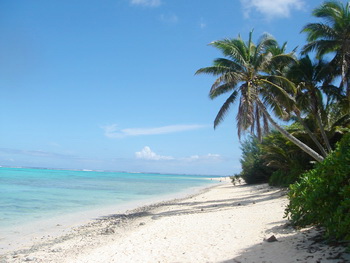
Muri Beach is the only one that is built up. An open-air restaurant with walls of palm fronds sits above the sand with a gorgeous view of the lagoon and motus beyond. It was the perfect place to stop and have a smoothie.

.
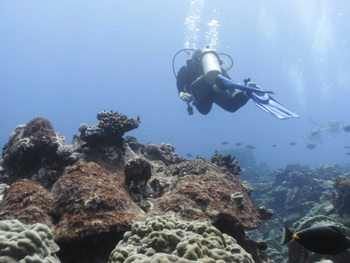
Diving on the outer reef of Rarotonga is incredible and worthy of its world class status. Not far from shore the ocean floor drops away rapidly to 4000 meters. Visibility is consistently 30 to 50 meters ... that's 100 to 200 feet! The water is a tepid 25C / 77F.
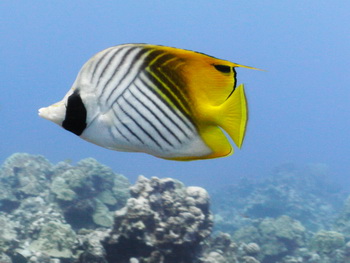
Peering over the side of the boat we were amazed at how clearly the bottom could be seen 12 meters below. Quickly gearing up, we rolled out backwards and descended to the bottom. We moved slowly among a plethora of brightly colored fish and over abundant coral to an area called Edna's Anchor where a large fishermans anchor rests mostly upright.

Tom, our divemaster, said that the water is so clear that a strobe wasn't needed but I wished I had taken it. Two lionfish posed nicely under coral which was too dark to capture well. Next time I am taking it regardless of what anyone says!
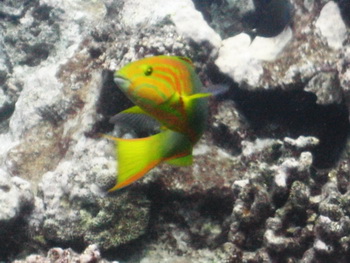
We went back to the harbor between dives and on our return were treated to a mama humpback whale and her baby cavorting nearby. Both breached and seemed to enjoy thrusting their flukes straight out of the water as high as possible before slapping them down forcefully, making enormous splashes, many times in a row. This same couple has been easily sighted from shore all week.
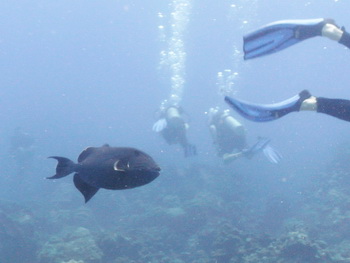
While we were descending, Tomy, a very large blue triggerfish, approached and checked everyone out. He proceeded to follow us the entire dive!
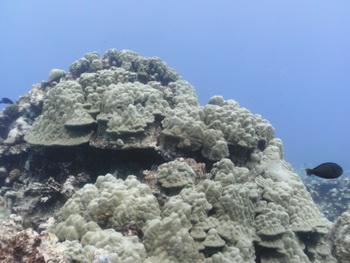
This dive was at Smurf City, aptly named for the mushroom shaped coral all over the bottom. In addition to Tomy we saw a white tipped reef shark resting on the bottom under an overhang, a huge maori wrasse, other smaller and colorful wrasses, emperor angelfish, striped large-eyed bream, achilles tang, threadfin butterflyfish and a half spotted hawkfish sitting on the coral among others I couldn't photograph so can't identify positively.
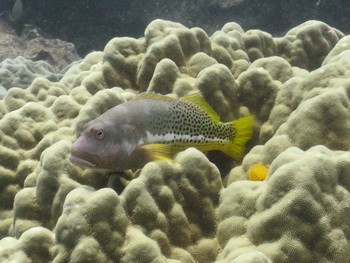
Ready for some exercise, we set out yesterday morning to hike the Cross Island Track which is a trail that leads from the Avatiu Harbor through agricultural land, up into the mountains to a highpoint called the Needle, down through giant ferns and other tropical foliage to the southern shore.

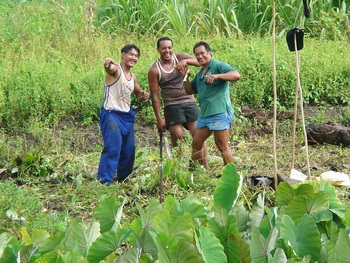
We walked about 3 kilometers along a gradually less developed road until we came to the trailhead, passing taro fields with friendly workers who hammed it up for the camera.

We hiked and scrambled up and up for over an hour until we reached the base of the Needle. As soon as we had pulled out our bagels and trail mix a brightly colored rooster and unattractive dark hen came prancing up quietly clucking. Bashful, the rooster wasn't.

Most of the trail is along the rivers running to each coast. What wonderful hiking! Walking under the tropical canopy listening to the water gurgle as it flowed over rocks and through chasms was breathtaking. We crossed the rivers so many times we lost count.
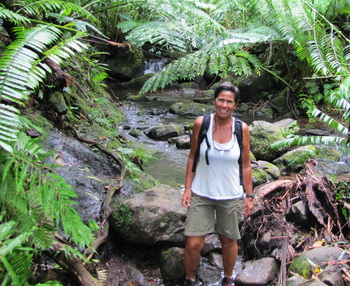
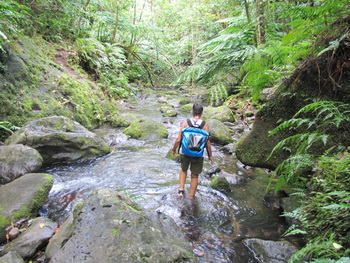
Beyond the Needle the trail is downhill, sometimes quite steep. Roots make for nice steps and where there are no good holds someone has kindly installed ropes.
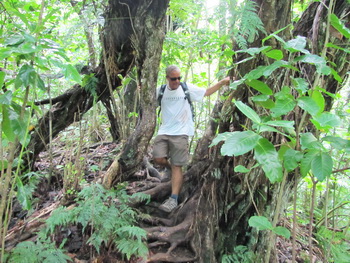

The guidebook said it was dangerous and not to attempt this hike after rainfall. Of course, it had rained the night before we went. The path was muddy, slippery and had lots of puddles so we moved slowly and carefully and got very, very dirty. What should have taken four hours took us five.
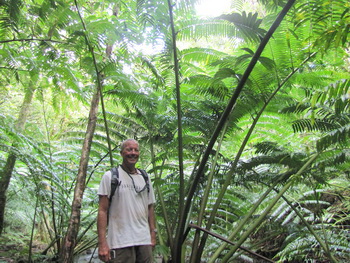
After passing through the tropical mountain forest we came to fernland, a hill covered in small tangle fern before emerging at Papau (Wigmore's) Waterfall. A refreshingly cool, clear pool was a wonderful place to take a swim and clean off before the hoards of mosquitoes descended on us. Amazingly, neither of us has a bite.

We have had a wonderful time on Rarotonga and absolutely love this island. The charming towns, beautiful beaches, gorgeous lagoons, amazing diving and spectacular hiking will be forever etched in our memories. The Cross Island Track has become our all-time favorite island hike!
All good things must come to an end and the wind is forecast to come from the north beginning tomorrow so we must hightail it out of here. Our next destination? With luck, Palmerston Island. If the wind continues more than three days from the north we will have to pass that unique island where all the inhabitants are descendants of one man, and head to Niue, our next destination.
Go to September 2010 Part One - Palmerston
.